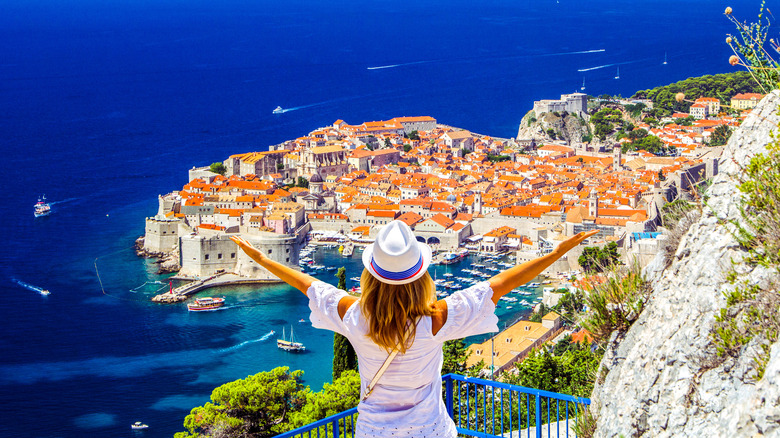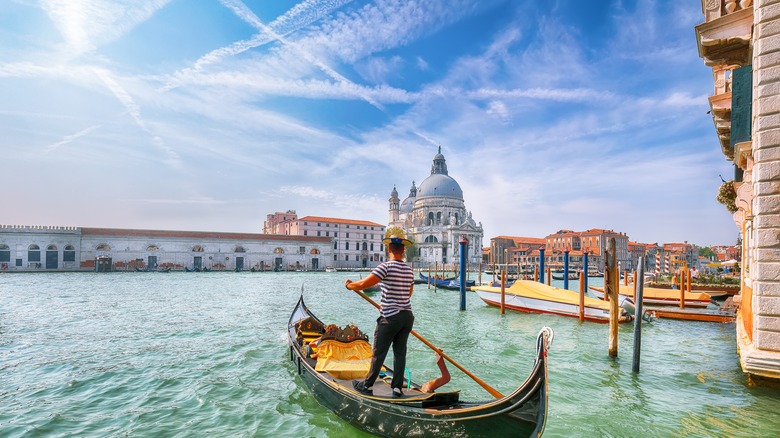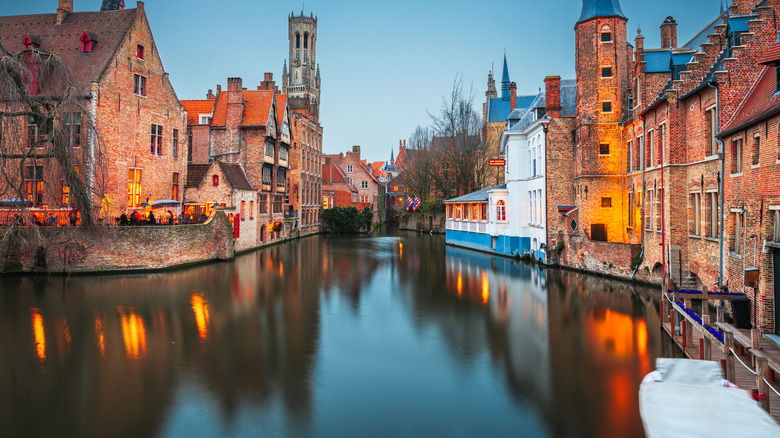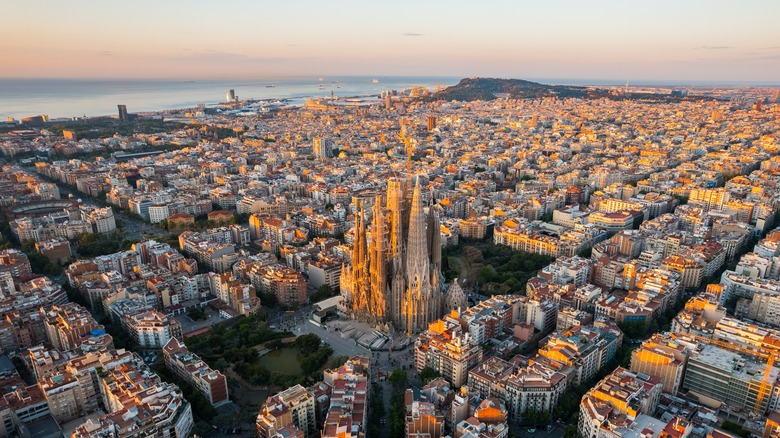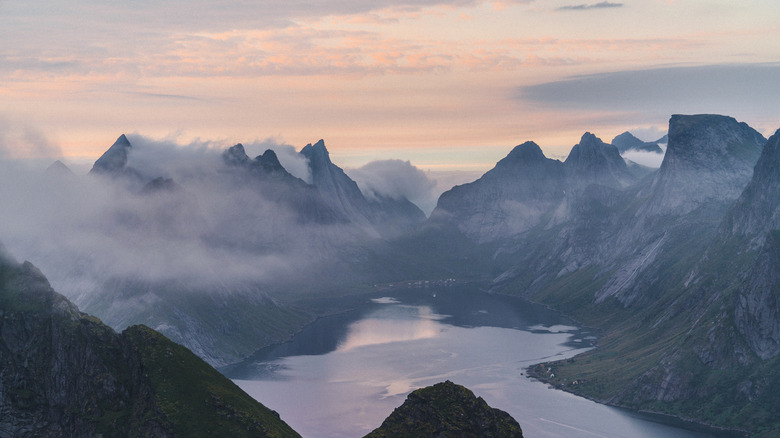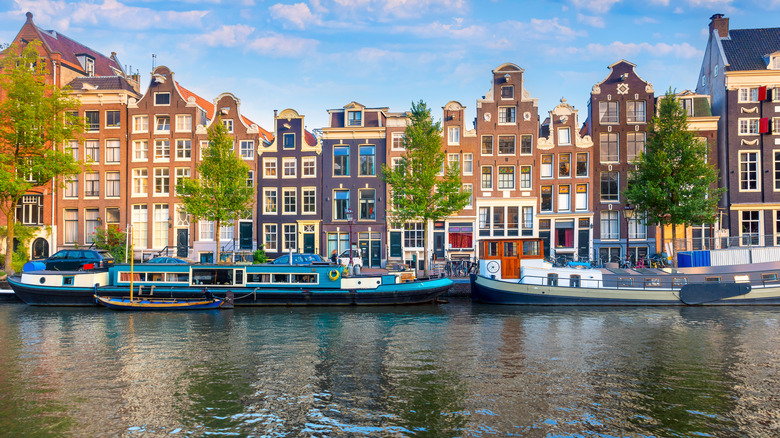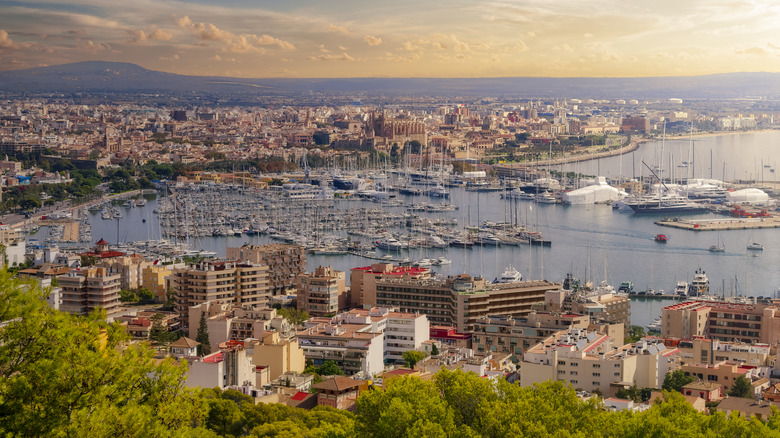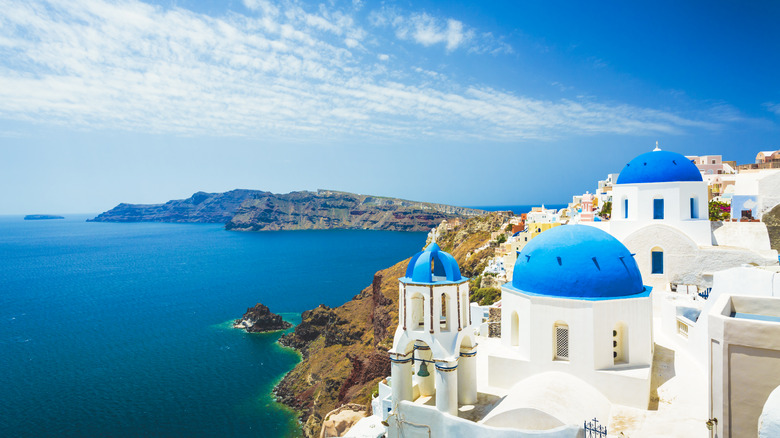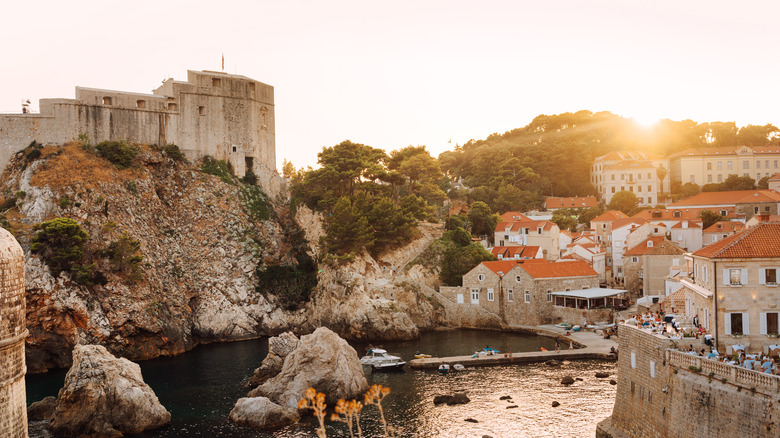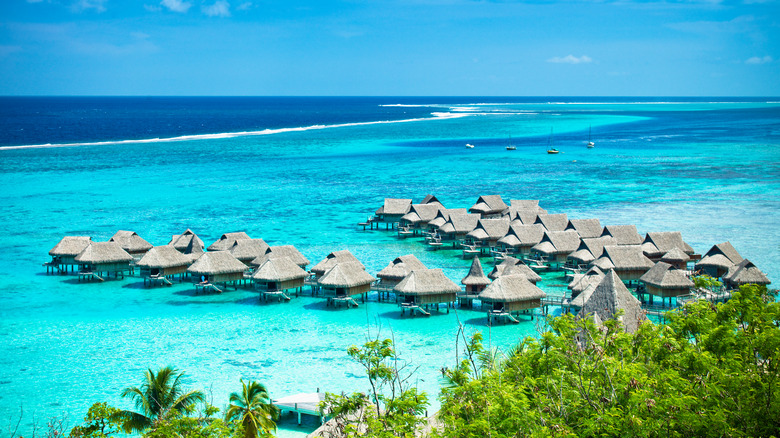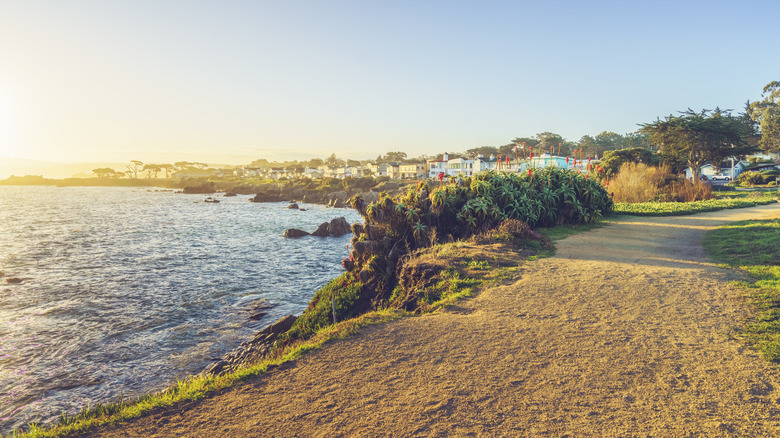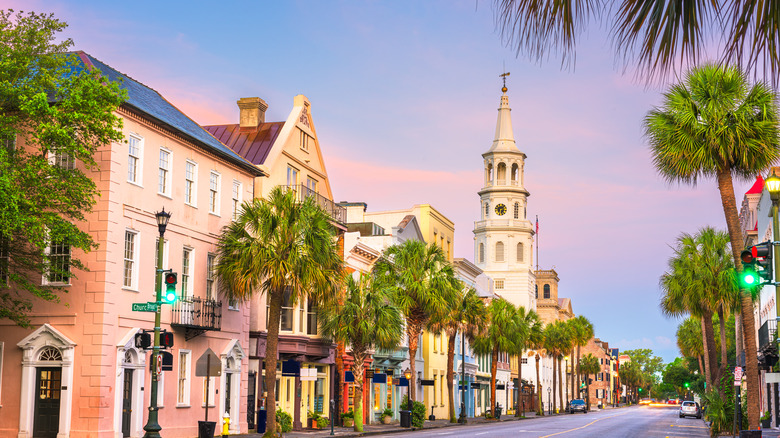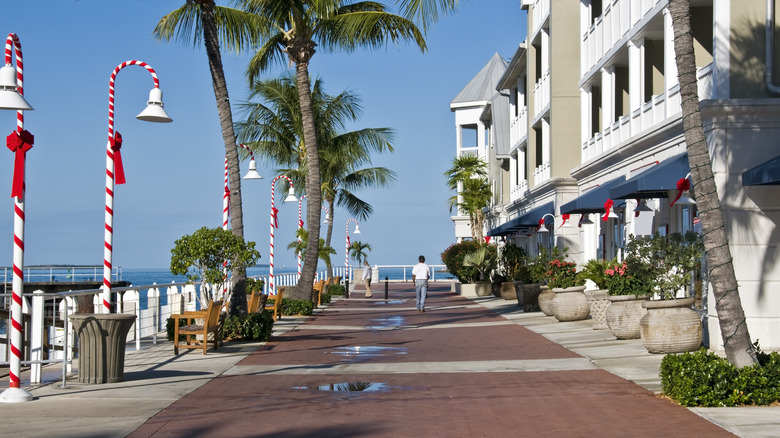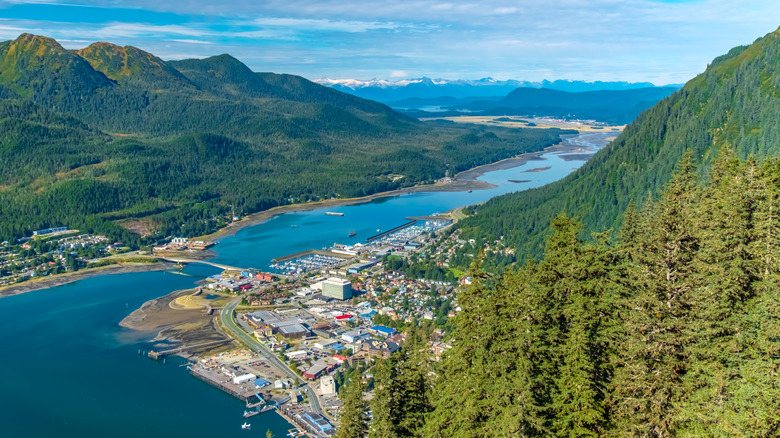Cruise Ship Travel Is Banned (Or Nearly) In These Cities
More people are hitting the high seas than ever. It's thought that 36 million people will embark upon a cruise ship in 2024, with that number nearing 40 million by 2027. Combining all-you-can-eat buffets with entertainment, adventure, and relaxation — not to mention an easy way to tick several countries off your bucket list at once — it's no surprise that this vacation method is soaring in popularity.
But not everybody is as pro-cruise as you may think. Over the years, tension has risen between several cities and the ships that dock on their shores multiple times a day, 365 days a year. Destinations throughout the Mediterranean, Caribbean, and other popular cruise routes have grown weary at the sheer amount of foot traffic generated by passengers.
While tourism is typically beneficial to a city's economy, a common complaint is that those who hop from ship to shore for a few hours aren't exactly excessive with their spending. Pollution is another major concern, as is the physical damage inflicted by big boats and crowds alike. In fact, some cities have grown so frustrated that they've banned (or nearly banned) cruise ships altogether.
Venice
This ancient city has long been a popular cruise destination — but not anymore. In August 2021, Italy's culture minister announced that large cruise ships were banned from entering Venice's Giudecca canal. This announcement came two years after an incident that saw the MSC Opera crash into a dock, leaving five people injured. With the UNESCO World Heritage Committee threatening to dub Venice an endangered city due to proof that ships were taking a toll on its infrastructure, it had no choice but to give cruises the boot.
While there were initially protests against the ban, big names in the cruise ship industry itself were surprisingly enthusiastic. The Cruise Lines International Association declared that "the cruise industry has been supportive of a new approach for many years" and that it was "a major step forward." Today, every passenger aboard any vessel weighing over 25,000 tons must disembark at the industrial port of Marghera and take a bus across the bridge to Rialto Bridge, Piazza San Marco, and other iconic sights.
Bruges
Famous for its narrow, cobbled streets, canals, and Christmas markets, Bruges is sometimes referred to as the "Venice of the North." Just like Venice, it has a complicated relationship with cruise ships and the hundreds of thousands of visitors it brings to the city each year. In 2019, Mayor Dirk De fauw implemented strict new measures to control Bruges' tourist population, which is said to triple the number of residents in the city center.
"We have to control the influx more if we don't want it to become a complete Disneyland here," he told local newspaper Het Nieuwsblad. Bruges now no longer advertises itself as a day-trip destination and has enforced a rule that only two cruise ships can moor in the city at a time. The goal is to bring in more "quality" tourists, and Bruges has decided that cruise ship passengers, who only spend a few hours in the city, don't provide a quality visit.
Barcelona
For years, Barcelona voiced its complaints about cruise ships in the Catalonian capital. The city is home to the busiest cruise port in Europe, which contributes to the city's pollution, and the city has shifted blame onto the cruise liners that frequent the area. Former mayor Ada Colau told The Times that many cruises only dock for four hours at a time and "don't give the city economic return," adding that the influx of crowds "create great mobility issues and then leave."
In October 2023, the city finally made a move to resolve the issue and tackle overtourism. Barcelona is officially off limits to cruises and ferries, which must stop at Moll d'Adossat — a pier 30 minutes away from the city center — instead. Those that do divert to the more distant port are also limited, with only seven cruise ships allowed to port per day. It's a victory for the city's crowding issue, but not so much for the passengers hoping to squeeze a bucket list Barcelona visit into a four-hour mooring.
Norwegian fjords
Flanked by dramatic steep cliffs, the famous fjords of Norway are some of the deepest in the world and have long been a regular route for cruisers. However, many cruisers will soon need to find another way to view the fjords, which are UNESCO World Heritage sites. By 2026, only zero-emission ships will be permitted to pass through the west fjords (which basically makes them off-limits to all medium and large cruiseliners).
Officials campaigned for the Norwegian Parliament to enforce some kind of legislation for years before the decision was made in 2018. In a release by UNESCO, Katrin Blomvik, director of the Geirangerfjord World Heritage Foundation, praised the move as a "brave resolution which will have a great positive impact on conserving our UNESCO World Heritage marine site" and "make the fjords the world's first zero emission zone at sea." As it stands, the Western Norway Research Institute estimates that cruise ships in Norway currently use about 170 million liters of fuel per year.
While ships will still be able to traverse some of the lesser-known fjords, this new legislation does impact popular sites like Geirangerfjord, Nærøyfjord, and Aurlandsfjord. For now, cruise lines such as Royal Caribbean and P&O Cruises still make port in the area, but hopeful voyagers will need to move quickly if they want to squeeze in a trip before the ban. In the meantime, the Norwegian cruise line Hurtigruten is working on developing its first net-zero vessels. Set to run entirely on electricity, not fuel, the company hopes to get its green technology into oceans by 2030.
Amsterdam
According to the BBC, local politician Ilana Rooderkerk once compared Amsterdam's population of cruise ship passengers to a "plague of locusts." That's why it wasn't too surprising when officials moved to crack down on ships berthing in the Dutch capital. In July 2023, the city council decided to make Amsterdam's main terminal off-limits to the vessels that dock there each year.
This decision was made to prevent cruise lines from contributing to overtourism in Amsterdam's historic city center. It's taken multiple steps to try and deter rowdy visitors in recent years, including launching the 'Stay Away' initiative — a "digital discouragement campaign" that tries to reduce the number of young, male tourists who visit the city to "go nuts," ban the smoking of marijuana outdoors, and restrict the sale of alcohol after 4 p.m. from Thursdays to Sundays.
Boozy troublemakers aside, it was also an effort to cut down on pollution. A 2021 study of the Marella Discovery — a cruise ship docked in Amsterdam — found that the ship released as much polluting nitrogen oxide as 370,000 cars driving in the city, which doesn't exactly align with Amsterdam's commitment to sustainability. The city is taking similar steps with its airport, cutting the number of passengers permitted to fly into Amsterdam Airport Schipol at certain times of the year.
Palma de Mallorca
Before the pandemic, nearly 2.5 million cruise ship passengers visited the sunny Balearic island to check out its cliffs, coves, and pristine beaches. However, that number has started to fall. In 2022 — two years after signing the Cruise 2030 Call for Action, which pushed for a more sustainable cruise industry alongside other popular destinations like Barcelona, Bergen, Cannes, and Malaga — the former local government implemented a new rule that only three ships can dock in the city at a time until 2026.
This ban hasn't gone down too well with those in the travel industry. In October 2023, eight organizations teamed up to call for the Balearic government to scrap the rule, with The Majorca Daily Bulletin quoting them as arguing, "Don't demonize cruise ship passengers, it is family tourism with a high spending power." Their biggest concern is that the 18% fall in foot traffic harms local businesses such as restaurants, bars, and souvenir shops. At least until the end of 2024, however, the restrictions will stay in place, meaning the Mediterranean island will continue to look a little emptier than usual.
Santorini
Santorini has spent years trying to become less popular. Known for its blue waters and stacked, whitewashed buildings, the Greek island is home to just over 15,000 permanent residents yet attracts hundreds of thousands of cruise passengers each year. Unsurprisingly, this has caused concerns about overcrowding — not to mention the environmental impact of doubling an island's population every day. A 2018 study by the Hellenic Ornithological Society and Germany's Nature and Biodiversity Union found that the idyllic island was suffering a surge in toxic air pollution due to the fumes emitted by big cruise liners.
In 2016, Santorini started taking action against overtourism. The number of passengers allowed to come ashore was capped at 8,000 per day, but some think this number should be even lower, especially during the busy summer cruise season. Residents have complained that mass tourists contribute too much plastic waste — thanks in no small part to the challenge of sourcing drinkable tap water in Santorini. Also, the influx of tourists caused property prices to soar, pushing out residents needing permanent accommodations. In short, cruise ship passengers aren't exactly welcome.
Dubrovnik
The Pearl of the Adriatic was already a hot spot for tourists in Europe –- but then "Game of Thrones" happened. With much of the fantasy series shot in Dubrovnik's Old Town, popular sites like the Minčeta Tower, Fort Bokar, and Pile Gate became must-visit destinations for passengers cruising down the Dalmatian coast. The problem is that all this footfall is damaging some of Croatia's most historical landmarks, including multiple UNESCO World Heritage sites.
Dubrovnik has responded by slowly introducing multiple restrictions, starting with a limit of two cruise ships per morning (and an additional ship in the afternoon) and a maximum of 5,000 passengers a day. It also began enforcing a daily tax in 2021, which helped to raise HRK 1,463,000 ($210,972) in its first year to improve Dubrovnik's transportation infrastructure, such as its roads. The City of Dubrovnik has also taken a close look at the schedule of when ships arrive and leave to gain better control of the flow of tourists entering Old City.
Bora Bora
With its crystal-clear waters, volcanic skyline, and swathes of luxury bungalows, Bora Bora is known as a honeymooner's paradise. The French Polynesian government is determined to preserve the beauty of this secluded getaway spot and avoid facing the same overcrowded fate as Hawaii and Fiji. It's also concerned about protecting the reef surrounding the island. "We are convinced that our ancestors left us a beautiful legacy," said French Polynesia's former president, Edouard Fritch, to The Sydney Morning Herald. "We have to enjoy it and grow it, but not destroy it."
Technically, cruise ship passengers are still allowed to come ashore in Bora Bora. However, in 2021, it was decided that starting January 1, 2022, only 1,200 passengers were permitted to do so each day. It was also announced that mega cruise ships with a capacity of over 3,500 were not welcome. "Both in terms of capacity and size, very large ships are not suited for our destination," the French Polynesian government shared in a statement. Considering that most major cruise liners feature capacities of upwards of 3,000 people and more, these restrictions may prevent many major cruise lines from sailing to Bora Bora.
Monterey
The thing that attracts most visitors to Monterey is also the reason why it's so anti-cruise ship. Beyond its sandy beaches lies Monterey Bay, which is home to everything from sea otters and killer whales to squids and sea turtles. Of course, cruise ships aren't exactly conducive to maintaining a marine-protected area.
That's why, in February 2023, Monterey terminated its passenger landing services for cruise ships. After a city council vote, it was announced that cruise ships that did plan to come ashore still could, but the ship wouldn't be assisted by city services to help facilitate its docking. None have opted to try thus far. Prior to the vote, up to 12 ships typically docked in Monterey each year while en route to Alaska or Mexico.
While it's not an outright ban, it sends a pretty strong message. In a report to the council, Monterey's city manager Hans Uslar wrote that he hopes it will "signal to the cruise ship industry that they are no longer welcomed by our city." The city previously took other steps to combat the damage done by cruise liners, pressing pause on new arrivals for five years until 2002, when ships agreed not to dump any waste into the bay.
Charleston
The days of cruising in or out of Charleston are coming to an end. South Carolina's most populous city has decided that by the end of 2024, cruise ships will no longer be able to start or end their journeys in Charleston Harbor. Ships will still be allowed to dock in the city — and passengers can still disembark to stroll down Rainbow Row or sample some Lowcountry cuisine — but they must depart on the same day.
Carnival Cruises previously started and ended around 70 Caribbean cruise routes from Charleston's Union Pier Terminal. However, the South Carolina Ports Authority decided against renewing their deal with the cruise line in 2022. It also ditched the decision to transform a warehouse on Union Pier into a cruise terminal, a project that drew plenty of protest from conservation and historical preservation groups. According to Mayor John Tecklenburg, the decision was made to slash the number of cruise ship passengers by 80% to improve the quality of life for Charleston's residents.
Key West
Residents of Key West are constantly waging war on the cruise industry. Located in the Straits of Florida, the island takes up just 4.2 square miles and boasts some of America's best beaches and reefs. While it's long been a stop for multiple cruise lines, its 27,000 residents got a taste of how peaceful life could be without a steady stream of ships during the COVID-19 pandemic and soon started petitioning for a permanent ban.
Although residents may not have gotten exactly what they asked for, they did record a major victory in 2022, when the city voted to strip back Key West's cruise ship schedule to one per day. Key West also moved to ban larger ships and prioritize cruise lines with strong environmental records. Key West's city government is currently in a legal battle with the state of Florida to put all of these restrictions into practice, but the sentiment is pretty clear: cruise ships are not welcome.
Juneau
For years, ships have weaved up and down the Gustineau Channel so passengers can take in its towering glaciers and sprawling rainforests. With no roads connecting the Alaskan capital to the rest of the state, it's not an easy place to access, which is probably one reason cruise travel exploded in popularity around the area. But in April 2023, an agreement was drawn up between the Juneau Assembly and the Cruise Lines International Association, capping the number of ships allowed to dock per day to five.
Overcrowding is to blame for the new limitations. While Juneau has a population of 31,685 people, cruise liners can bring thousands of passengers into the city each day. Some think the measures should've been even more strict, but the city has been cautious of doing too much too soon. "Some people will say it's not a big enough step," said Juneau mayor Beth Weldon, according to Alaska Public Media. "I would say at least it's a step. We're going to be the first Assembly that has actually tried to tackle some of these issues, so give us some time to ease into it."
